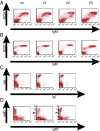Mice with megabase humanization of their immunoglobulin genes generate antibodies as efficiently as normal mice
- PMID: 24706856
- PMCID: PMC3986188
- DOI: 10.1073/pnas.1324022111
Mice with megabase humanization of their immunoglobulin genes generate antibodies as efficiently as normal mice
Abstract
Mice genetically engineered to be humanized for their Ig genes allow for human antibody responses within a mouse background (HumAb mice), providing a valuable platform for the generation of fully human therapeutic antibodies. Unfortunately, existing HumAb mice do not have fully functional immune systems, perhaps because of the manner in which their genetic humanization was carried out. Heretofore, HumAb mice have been generated by disrupting the endogenous mouse Ig genes and simultaneously introducing human Ig transgenes at a different and random location; KO-plus-transgenic humanization. As we describe in the companion paper, we attempted to make mice that more efficiently use human variable region segments in their humoral responses by precisely replacing 6 Mb of mouse Ig heavy and kappa light variable region germ-line gene segments with their human counterparts while leaving the mouse constant regions intact, using a unique in situ humanization approach. We reasoned the introduced human variable region gene segments would function indistinguishably in their new genetic location, whereas the retained mouse constant regions would allow for optimal interactions and selection of the resulting antibodies within the mouse environment. We show that these mice, termed VelocImmune mice because they were generated using VelociGene technology, efficiently produce human:mouse hybrid antibodies (that are rapidly convertible to fully human antibodies) and have fully functional humoral immune systems indistinguishable from those of WT mice. The efficiency of the VelocImmune approach is confirmed by the rapid progression of 10 different fully human antibodies into human clinical trials.
Keywords: antibody generation; immunoglobulin loci.
Conflict of interest statement
Conflict of interest statement: Several authors are employed by Regeneron Pharmaceuticals, Inc.
Figures



References
-
- Lonberg N. Fully human antibodies from transgenic mouse and phage display platforms. Curr Opin Immunol. 2008;20(4):450–459. - PubMed
-
- Chan AC, Carter PJ. Therapeutic antibodies for autoimmunity and inflammation. Nat Rev Immunol. 2010;10(5):301–316. - PubMed
-
- Leavy O. Therapeutic antibodies: Past, present and future. Nat Rev Immunol. 2010;10(5):297. - PubMed
-
- Beck A, Wurch T, Bailly C, Corvaia N. Strategies and challenges for the next generation of therapeutic antibodies. Nat Rev Immunol. 2010;10(5):345–352. - PubMed
MeSH terms
LinkOut - more resources
Full Text Sources
Other Literature Sources
Molecular Biology Databases
Research Materials
Miscellaneous

